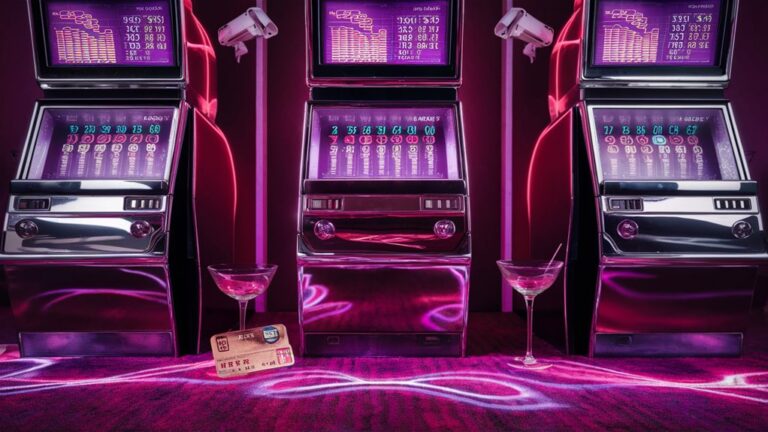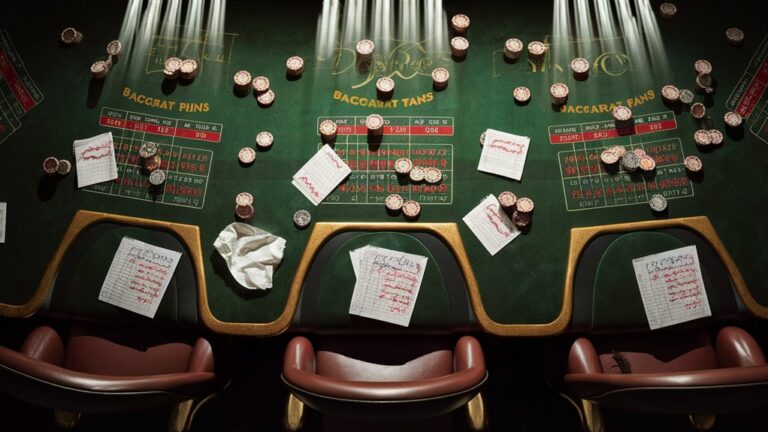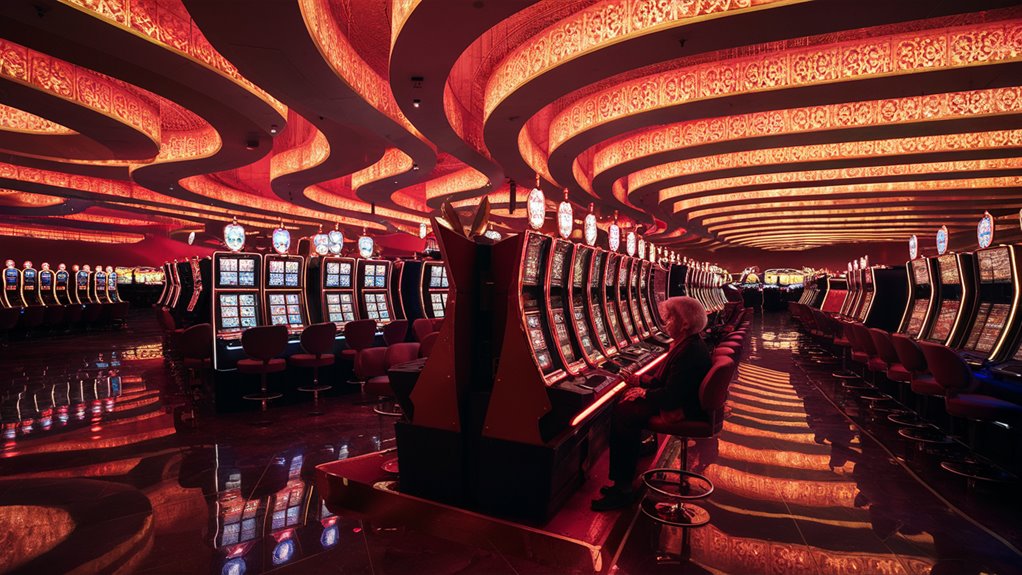
Ever wonder why casinos feel like time machines where hours slip by in what seems like minutes? Well, it’s not just your imagination playing tricks on you. Casinos are incredibly clever at using psychology to keep you engaged, and honestly, most of us don’t even notice how they do it.
Think about the last time you walked into a casino. Everything from the winding paths between gaming tables to those catchy little tunes coming from the slot machines serves a purpose. It’s like being in a carefully choreographed dance where the casino leads, and we follow without even realizing it.
You know how your favorite stores arrange their layouts to keep you browsing longer? Casinos take that concept to a whole new level. The sounds, lights, and even the air you breathe are all part of their master plan to keep you playing. And let’s be real, even when we think we’re making our own choices about when to hold ’em or fold ’em, the casino has already shaped our experience through dozens of subtle tricks.
The really fascinating part? These psychological tactics are so smoothly integrated that they feel completely natural. Those jingling slot machines aren’t just making noise, they’re speaking to our brains in a language designed to keep us engaged. And that maze-like floor plan? It’s not poor architecture, it’s actually brilliant design meant to keep you exploring just a bit longer.
The Architecture of Distraction
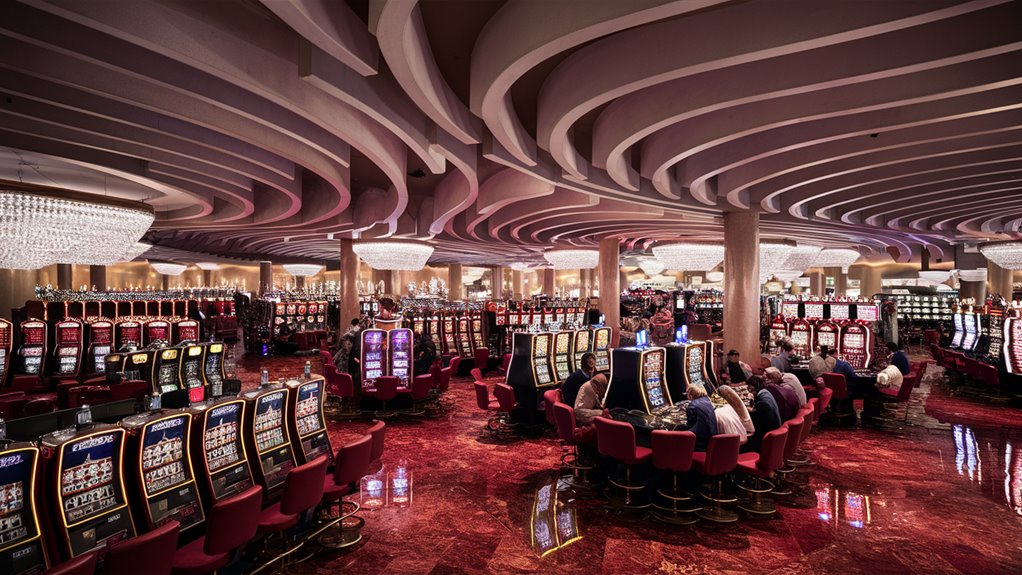
Let’s talk about something fascinating – the clever ways casinos use architecture to keep us playing. You know how you sometimes feel a bit lost in these places? Well, that’s exactly what they want.
Casino designers are masters at creating confusing layouts that make you wander through gaming areas while searching for simple things like the restroom or restaurant.
Think about the last time you were in a casino. Notice how you couldn’t find any clocks or windows? That’s no accident. They create this timeless bubble where you lose track of whether it’s noon or midnight.
The lighting is pretty sneaky too – it’s always set to this perfect twilight level that keeps you alert but cozy, no matter what time it’s outside.
They’re pretty clever with their floor plans as well. Casinos create what they call “dead spaces,” which is just a fancy way of saying they put obstacles in your path.
Those slot machines that seem randomly placed? They’re actually strategically positioned to make you zigzag through gaming areas instead of walking straight to where you want to go.
And have you ever noticed those crazy carpet patterns? They’re intentionally busy and complicated, sort of like a visual noise that keeps your eyes focused on the games instead of looking for the nearest exit.
Even the routes to essential spots like restaurants and bathrooms are carefully planned. They’ll line these high-traffic paths with their most attractive games and flashiest machines.
It’s like going to a grocery store where you have to walk through the candy aisle to reach the milk – they know exactly what they’re doing.
Sound Design and Sensory Manipulation
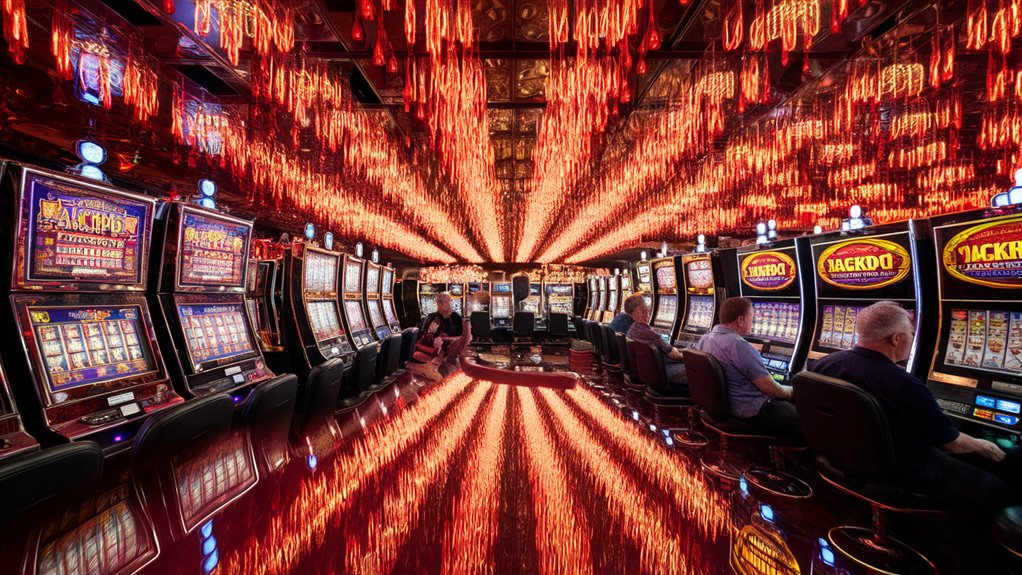
Ever wondered why casinos sound the way they do? Well, it’s no accident.
The whole audio experience breaks down into three main parts: those cheerful slot machine sounds that never seem to stop, the exciting winner’s music that gets everyone’s attention, and the smooth background tracks that fill in any quiet moments.
You know how slot machines keep singing their little tunes even when no one’s playing? That’s totally on purpose – they’re like sirens calling out to players with promises of potential wins.
But here’s the interesting part: these aren’t just random pleasant sounds. They’re actually designed to get your brain pumping out dopamine, that feel-good chemical we all love.
When someone hits a jackpot, the machine doesn’t just quietly pay out. Instead, it puts on a whole show with music and chimes that everyone nearby can hear. Pretty clever, right? Most of these winning sounds are actually in C major, which scientists have found makes people feel more optimistic and happy.
Think about the background music you hear while walking through a casino. It’s carefully chosen to hit just the right tempo, keeping you alert but not worn out.
And that overall noise level? It’s like being in a bubble, where time seems to stand still and the outside world just fades away. This creates this cozy little gaming universe where it’s just you and the excitement of the game.
The whole setup is pretty 먹튀검증 fascinating when you stop to think about it – every sound has its purpose in keeping players engaged and entertained.
Color Psychology in Casino Spaces
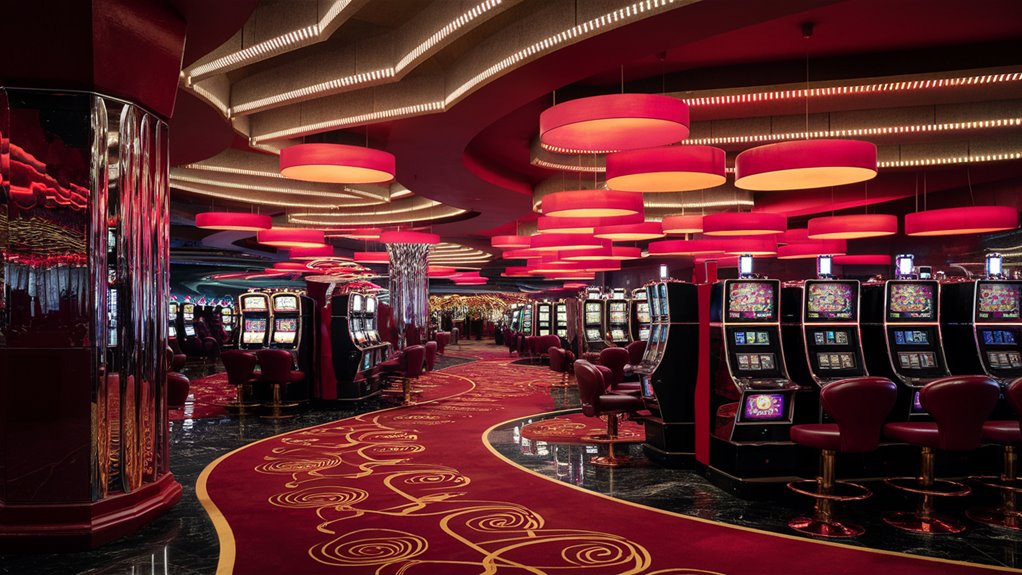
Have you ever wondered why casinos seem to have such a specific color scheme? Well, there’s actually some fascinating psychology behind those color choices, and it’s all designed to keep you playing just a bit longer.
Let me tell you about the reds you’ll spot everywhere on the casino floor. These aren’t random splashes of color – they’re there because red gets your heart pumping and your energy levels up.
Think about it: when you’re feeling energized, you’re more likely to take that extra spin or place that slightly bigger bet.
The really clever part is how casinos layer their colors. You might notice warm, welcoming oranges and yellows in social areas, making you feel right at home.
It’s like walking into a friend’s living room – you just want to stick around and chat.
Now, if you venture into the high-roller areas, you’ll spot something interesting. Rich purples and deep blues dominate these spaces, and it’s no accident.
These colors make us think of royalty and luxury, which is exactly what you want when you’re placing those big bets.
But here’s something you mightn’t have picked up on: the transition areas and restaurants often use calmer, earthier tones. It’s like giving your eyes a little breather before you head back to the action.
Pretty smart, right?
And don’t get me started on the lighting. You won’t find any harsh fluorescent lights here – casinos opt for soft, warm lighting that works with their color schemes.
It’s all part of creating this timeless bubble where you lose track of whether it’s noon or midnight.
Time Distortion Techniques
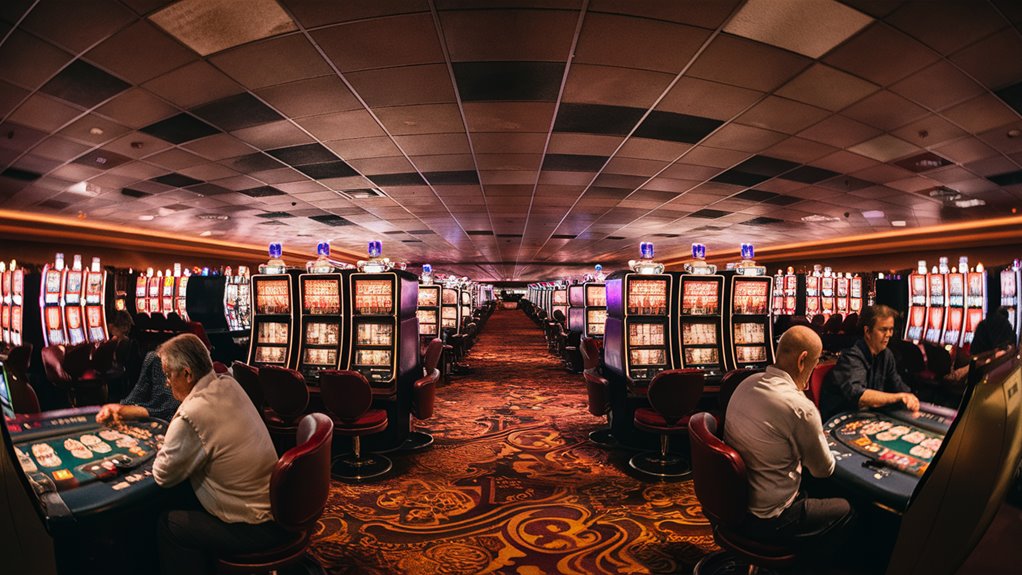
Ever noticed how easy it’s to lose track of time in a casino? Well, these places are actually designed to mess with your sense of time, and they’re pretty clever about it too.
You won’t find any clocks on the walls, and good luck spotting windows – they keep natural light out on purpose, so you can’t tell if it’s noon or midnight.
Think about it: everywhere you look, there’s this perfect, unchanging environment.
The lighting stays at this dreamy twilight level, the temperature’s just right, and there’s this constant buzz of activity that never seems to change.
The familiar ding-ding-ding of slot machines mixes with background music to create this kind of hypnotic bubble around you.
Getting around a casino is kind of like navigating a fancy maze.
Just when you think you’re heading for the exit, something catches your eye – maybe it’s a flashy new game or an enticing restaurant.
Before you know it, you’re deep in the action again.
They even pump extra oxygen into the air to keep you fresh and alert, no matter how long you’ve been there.
You know that feeling when you’re so caught up in something that time just flies by? Psychologists call it a “flow state,” and casinos are masters at getting you there.
Without any reminders of the outside world, you can easily slip into this weird time warp where hours feel like minutes.
It’s pretty wild how they’ve figured out exactly what makes us tick, isn’t it?
Near Misses and Reward Patterns
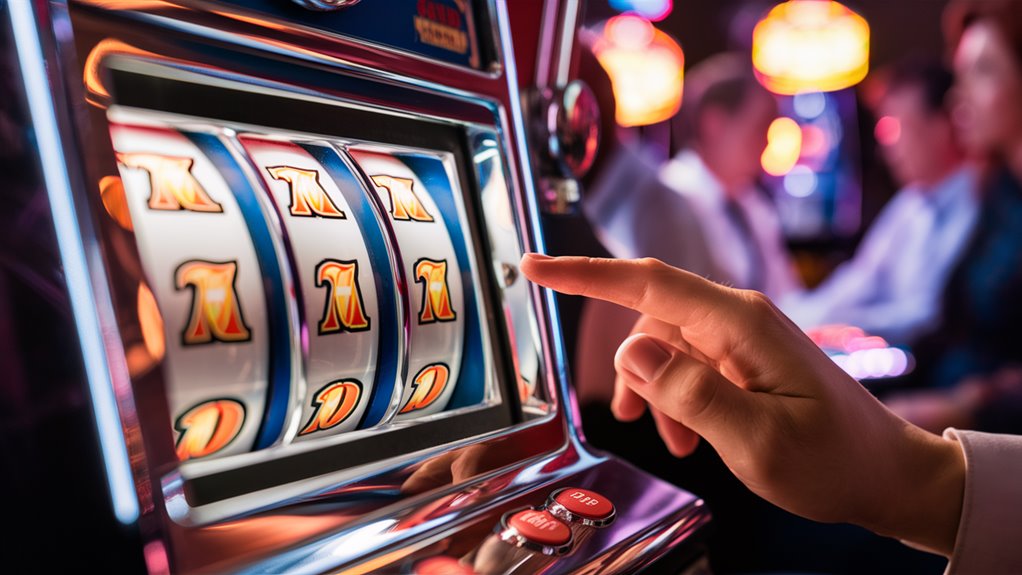
Ever wondered why slot machines and roulette wheels can be so captivating? Well, it all comes down to those heart-stopping moments when you’re just one symbol away from hitting the jackpot.
You know the feeling – your heart races, and you can’t help but think “I was so close!” The interesting thing is, these near misses light up your brain almost as much as actual wins do. Your brain releases dopamine, that feel-good chemical, even though you technically lost.
Casino designers are pretty clever about this whole thing. They’ve carefully programmed their machines to create these almost-won moments at just the right times.
Maybe you’ve noticed how those winning symbols tend to stop right above or below the payline, making you feel like victory is just within reach. It’s no accident, and it keeps players coming back for more.
Think about it like this: you’re more likely to keep playing when you get a mix of these near misses and occasional small wins 최고의카지노 rather than just losing over and over.
It’s similar to how a fisherman keeps casting their line after feeling a few nibbles. Psychologists call this a “variable ratio reinforcement schedule,” which is just a fancy way of saying your brain gets hooked on the possibility of winning.
The crazy part? Even though the odds never change, your brain starts associating those close calls with eventual success. Pretty sneaky, right?
Social Proof on Display
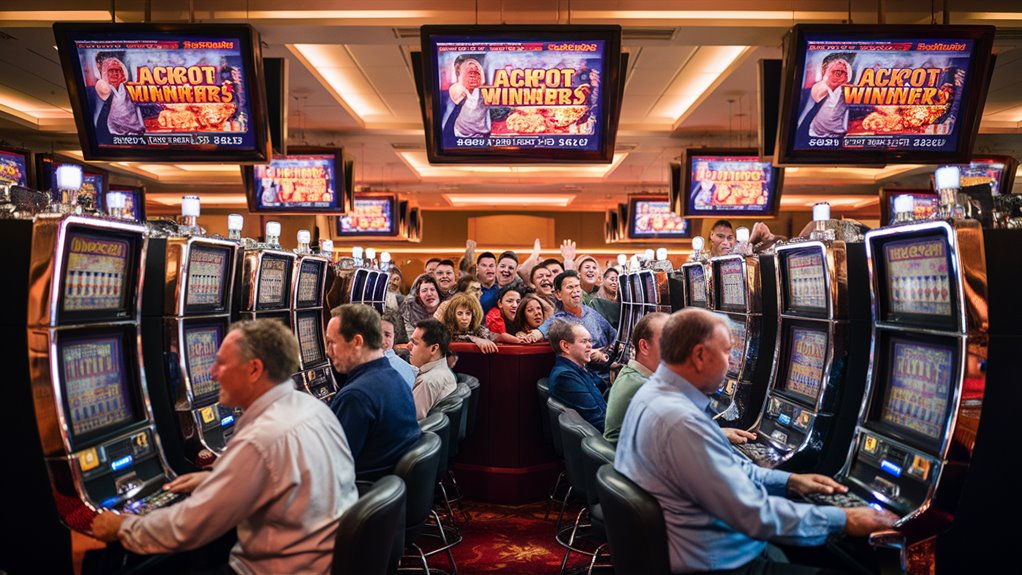
Let’s talk about how casinos create an atmosphere of winning that’s hard to resist. You know how it feels when you’re walking through a casino and suddenly hear cheering and bells ringing? That’s no accident.
Casinos carefully design these moments to make winning feel like it’s happening all around you.
Take a stroll through any casino floor, and you’ll spot those big digital screens everywhere. They’re constantly showcasing happy winners with their names, smiling faces, and impressive jackpot amounts.
It’s pretty clever, really. These displays make you think, “Hey, if that regular person can win big, why not me?”
Even though most modern slot machines use digital tickets now, you’ll still hear that classic sound of coins dropping. It’s funny how that familiar jingling sound still gets our attention, right?
The casino keeps playing these winning sounds because they know it creates this infectious excitement in the air.
And have you noticed how certain games always seem to draw a crowd? That’s because casinos deliberately place their most popular games where everyone can see them.
Picture this: you’re walking by a craps table where people are high-fiving and celebrating. It’s hard not to feel like you’re missing out on something amazing.
Before you know it, you’re thinking, “Maybe this is my lucky night too.”
The whole setup works like a well-orchestrated show, making you feel like winning is just part of the regular casino experience.
Between the flashing lights, victory sirens, and crowds of excited players, it’s easy to get caught up in the moment and believe that your big win is just around the corner.
The Illusion of Control
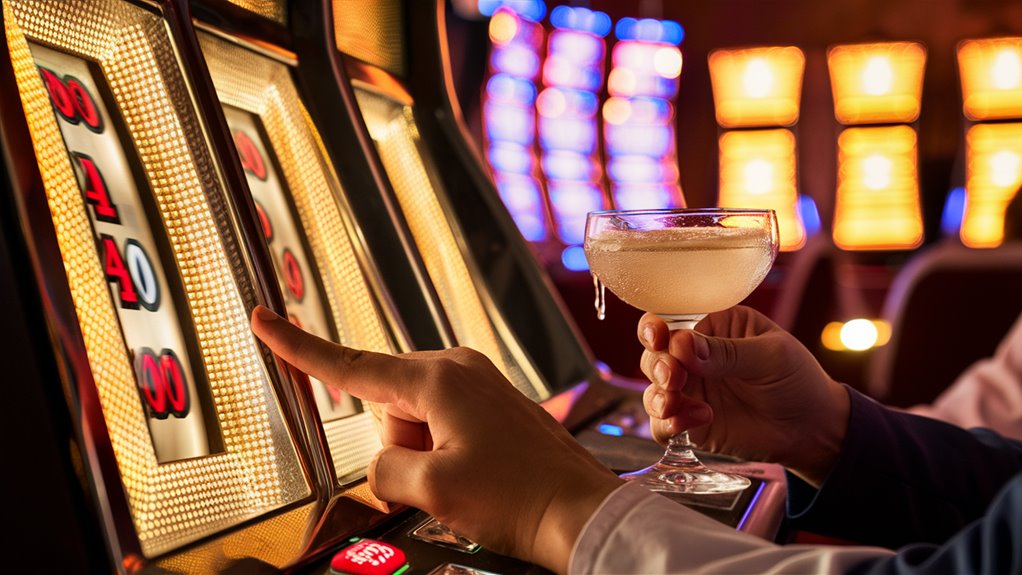
You know how we all love feeling in control? Well, here’s something fascinating about casino games like poker and blackjack.
Sure, you’re making real choices at the table, and it feels like you’re calling the shots. The casinos really play into this, don’t they? They’ll hand you these neat strategy cards and even offer gaming lessons, making you feel like you’re becoming quite the expert.
But here’s the thing – there’s a clever trick at play. While you’re busy making decisions and feeling like you’re mastering the game, the house edge stays exactly the same.
It’s kind of like thinking you can control the weather by carrying an umbrella. Nice try, but Mother Nature has other plans!
Your brain has this funny way of making you feel more in control than you actually are. It’s just how we’re wired as humans.
And boy, do casinos know this well. They’ve practically turned it into an art form, using this natural tendency to keep you glued to your seat. Pretty sneaky, right?
Think about it this way: you might pick the perfect moment to hit or stand in blackjack, and sometimes it works out great.
But at the end of the day, those wins have more to do with luck than skill. The casinos? They’re just sitting back, knowing that time and probability are on their side, while we keep believing we’ve got some special system figured out.
Strategic Comfort and Convenience
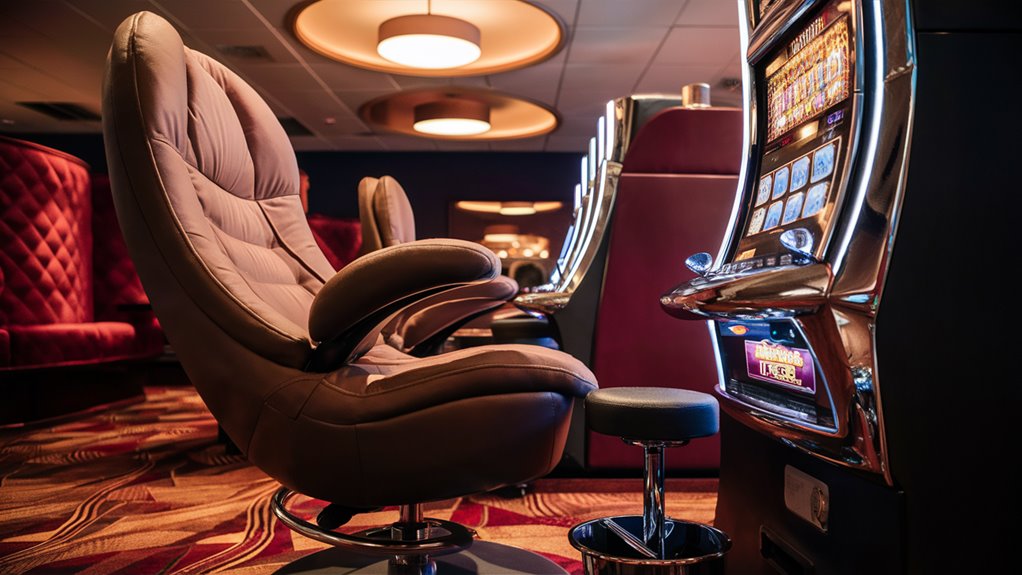
You know how some places just make you feel right at home? Well, modern casinos have pretty much mastered this art. The moment you walk through those doors, everything around you is carefully planned to keep you comfortable and relaxed.
Think about it – you’re stepping into this perfectly temperature-controlled space where finding what you need is super easy. Need a bathroom break? There’s one nearby. Getting hungry? Restaurants are just around the corner. Feeling thirsty? Someone’s always ready to bring you a complimentary drink right where you’re playing.
The smart thing about casino layouts is how they keep everything within reach. You won’t have to trek across the building to try different games, and if you need cash, ATMs are conveniently scattered throughout the floor.
The seating is really well thought out too. Those chairs at the slot machines and gaming tables? They’re designed to keep you comfy even during long gaming sessions, kind of like those ergonomic office chairs you’d find in a high-end workplace.
Have you ever noticed the carpeting in casinos? It’s not just there to look pretty. They’ve chosen special materials that are gentle on your feet, so you can walk around for hours without feeling tired.
And here’s something interesting: you won’t find many clocks or windows around. The lighting stays constant, the temperature never changes, and there’s always this subtle background buzz that makes you feel like you’re in your own little world.
Before you know it, hours can slip by while you’re caught up in the excitement of the games.
Common Questions
How Much Do Casinos Spend Annually on Psychological Research and Player Behavior Analysis?
You might be surprised to learn just how much casinos invest in understanding what makes players tick. The big players in the gambling industry, like MGM and Caesars, pour somewhere between $200-300 million each year into behavioral research and player analytics. While these numbers aren’t officially published, industry insiders regularly hint at these substantial investments.
Think about it – casinos basically function as massive psychology labs. They study everything from how players react to different lighting and sound effects to what motivates someone to keep playing after a loss. It’s fascinating stuff, really. They track player behavior patterns, analyze spending habits, and even research the effectiveness of their loyalty programs.
The biggest casino operators have entire departments dedicated to this kind of research. They employ behavioral scientists, data analysts, and psychology experts who work round the clock to understand player decisions. It’s like having a Fortune 500 company’s marketing department focused solely on figuring out what makes gamblers tick.
Of course, each casino group handles their research budget differently. Some focus more on high-tech solutions like AI-powered player tracking, while others invest heavily in traditional focus groups and surveys. But one thing’s for sure – they’re all in on the game of understanding their customers better.
What Percentage of Casino Players Are Actually Aware of These Psychological Techniques?
You know what’s fascinating? Research shows that only a small slice of casino players, around 15-20%, actually realize they’re being influenced by carefully crafted psychological techniques. Think about that for a minute. The vast majority of people hitting the slots or sitting at blackjack tables have no idea how casinos subtly shape their choices and behavior.
It’s kind of like walking into a supermarket without realizing why the milk is always at the back of the store, or why those tempting snacks are right by the checkout. The same thing happens in casinos, but on a much bigger scale. Most players are so caught up in the excitement of the games that they don’t notice the strategic layout, the carefully timed sounds, or even the specific color schemes used to keep them playing.
The reality is, while experienced gamblers might recognize some of these tactics, the average player is just focused on having fun and hopefully winning big. They’re not thinking about how the free drinks, the maze-like layouts, or even the background music are all part of a carefully designed experience to influence their gaming decisions.
Do Psychological Engagement Techniques Vary Between Different International Casino Markets?
You know, it’s fascinating how casinos around the world play different psychological games with their visitors. Let’s break down what makes each market unique.
In Asian markets, you’ll notice a huge emphasis on luck and fortune. Walk into a casino in Macau or Singapore, and you’ll spot red decorations everywhere, the number 8 showing up in mysterious places, and designs that practically scream good fortune. Why? Well, these cultural touchstones really resonate with local players who take their lucky charms seriously.
Western casinos, particularly in Las Vegas or Monte Carlo, tell a completely different story. Here, it’s all about making you feel like a high roller, regardless of your bankroll. Think bright lights, winner’s bells ringing non-stop, and those massive jackpot displays that make your heart race a little faster.
The psychology gets even more interesting when you look at how different markets handle their gaming floor layouts. Australian casinos often create cozy, intimate spaces for their pokies (that’s what they call slot machines down under), while American venues tend to go for that grand, open-plan setup that makes you feel like you’re part of something bigger.
Local regulations shape these differences too. Some markets have strict rules about how rewards can be presented, while others let casinos go all out with their psychological tricks. It’s kind of like each casino market has developed its own personality based on what works best for local players.
How Often Do Casinos Update or Modify Their Psychological Engagement Strategies?
You know, casinos are pretty fascinating when it comes to staying on top of their game. They’re constantly tweaking and fine-tuning their engagement strategies, kind of like how a chef adjusts recipes based on customer feedback. Most casinos review their approaches monthly, making small adjustments here and there, while bigger overhauls typically happen every quarter.
Think of it as a living, breathing system. Casino managers analyze player behavior daily, much like how social media platforms track user engagement. They look at everything from how long players stay at certain machines to which promotional events draw the biggest crowds. Sometimes they’ll notice a particular strategy isn’t working quite as well as expected, so they might adjust it on the fly.
It’s worth noting that these updates aren’t random. Casinos rely heavily on sophisticated data analytics and behavioral psychology to guide their decisions. They might test out new lighting patterns, adjust the timing of their bonus rewards, or even reorganize their gaming floor layout based on what the numbers tell them.
The frequency of these changes really depends on the casino’s size and resources. Bigger establishments might roll out updates more frequently, while smaller venues might stick to quarterly revisions. But one thing’s for sure – in the competitive world of gaming, standing still isn’t an option. These places are always looking for ways to keep their psychological engagement strategies fresh and effective.
Are There Regulations Limiting How Casinos Can Implement Psychological Manipulation Techniques?
You know, casino regulations are pretty interesting when you look at them closely. While different places have their own rules, most regulators actually focus more on keeping games fair and helping problem gamblers than controlling specific mind games casinos might use. It’s kind of surprising, but there’s often not much oversight when it comes to the psychological tricks casinos employ.
Think about it like this: while you’ll find strict rules about how slot machines need to pay out and requirements for posting addiction helpline numbers, there’s usually a lot more wiggle room when it comes to things like atmospheric design and reward systems. That said, some places are starting to catch up. A handful of jurisdictions have put limits on certain features, like flashing lights or those exciting victory sounds that make you want to keep playing.
What’s really fascinating is how casinos can still use most of their tried-and-true psychological techniques completely within the bounds of the law. From the maze-like layouts to the carefully chosen colors and sounds, most of these subtle influence strategies remain largely unregulated. The focus tends to stay on the numbers and hard data rather than the softer side of casino psychology.

